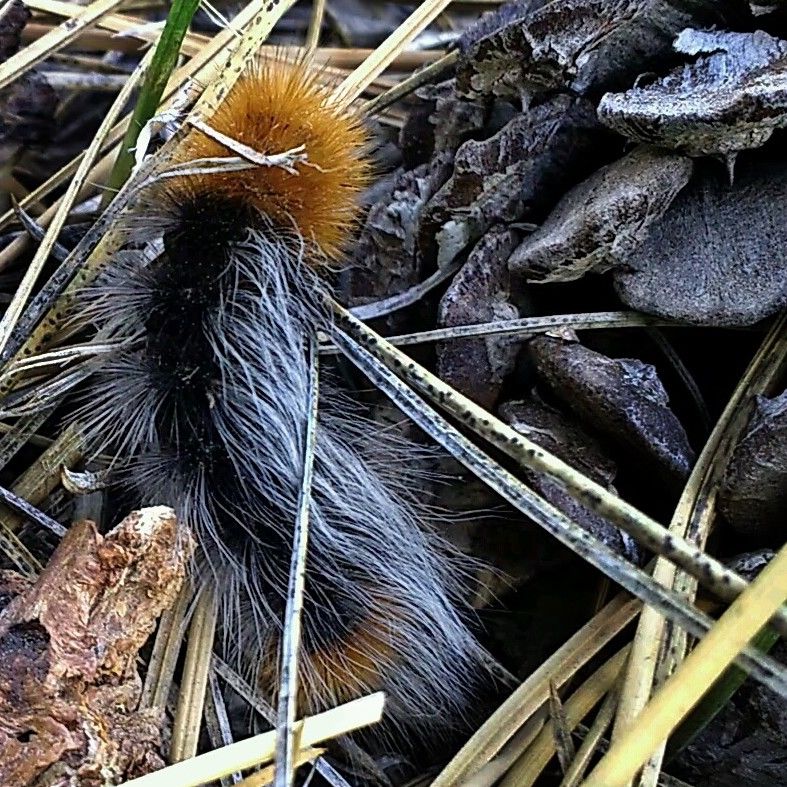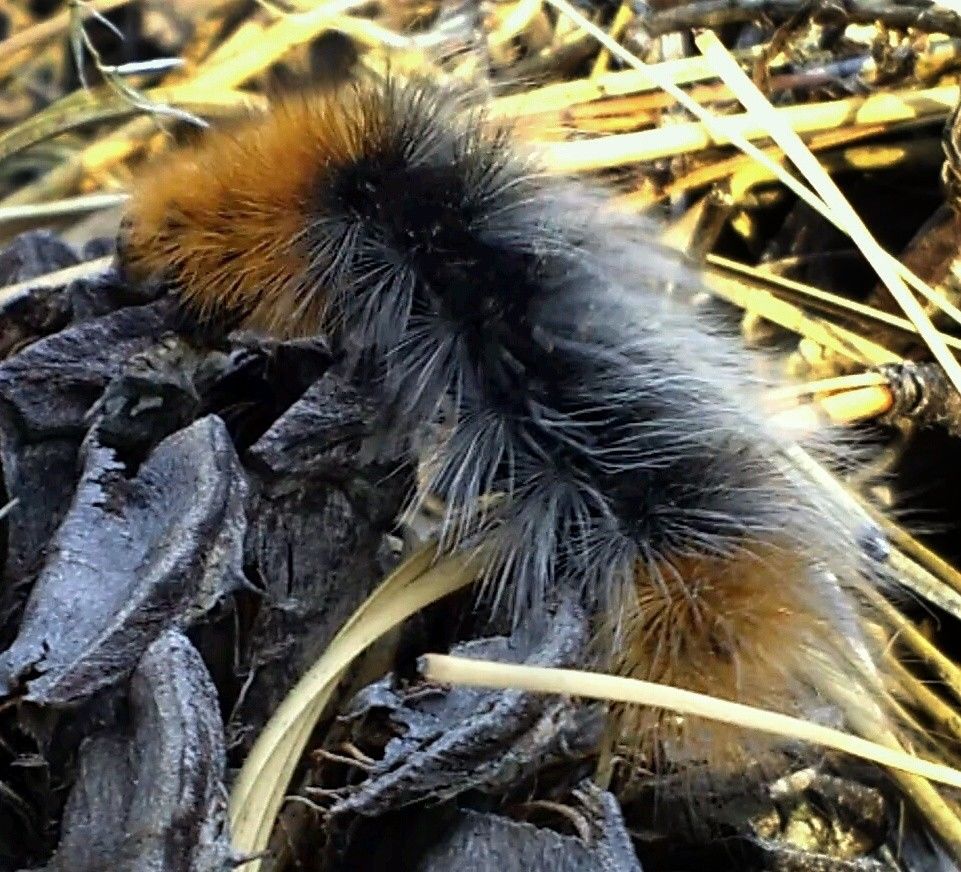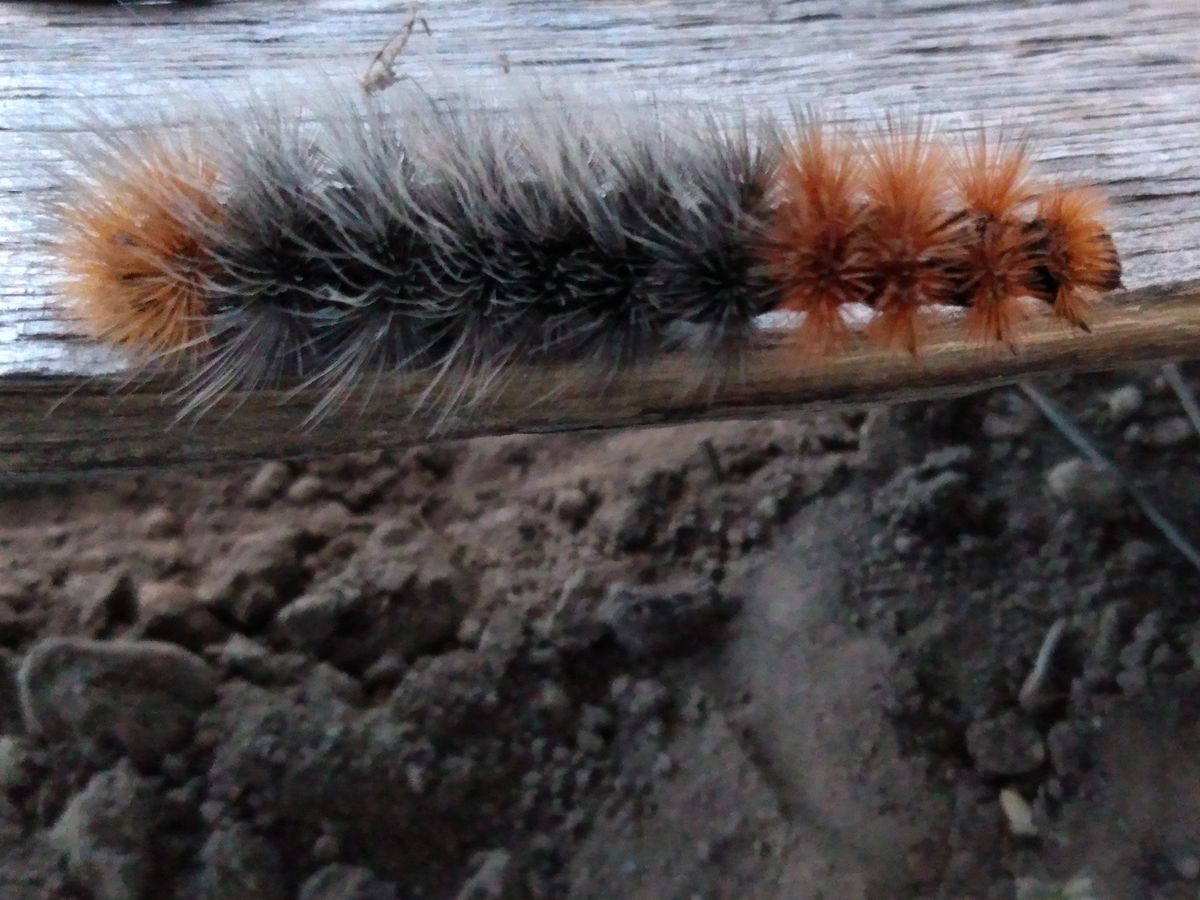Black-orange-black. Orange-black-orange. Are both wooly worms?
May 10, 2022 04:19:18 #
Black ends and orange middle seems to be the described pattern for the wooly worm.
Is this one probably a mutation with its orange ends and black middle....and such long white hairs?
Online searching hasn't helped answer the questions. Maybe all my search terms are wrong, dunno.
Anyone with enough experience in entomology and lepidoptera to help explain the one in these pics?
Is this one probably a mutation with its orange ends and black middle....and such long white hairs?
Online searching hasn't helped answer the questions. Maybe all my search terms are wrong, dunno.
Anyone with enough experience in entomology and lepidoptera to help explain the one in these pics?



May 10, 2022 06:13:02 #
May 10, 2022 06:30:57 #
Who was the stylist for this hairdo? The orange is youthful, and the touch of gray denotes maturity.
Mr Google is an expert and gave this info:
https://www.projectnoah.org/spottings/157666037
http://www.wildlifeinsight.com/british-moths/garden-tiger-moth-and-wooly-bear-caterpillar-arctia-caja/
The Garden Tiger Moth caterpillar grows to about 55mm long and is often referred to as the ‘Woolly Bear’ caterpillar because of its long hairs.
http://www.wildlifeinsight.com/guide-to-british-caterpillars/identifying-hairy-caterpillars/
Mr Google is an expert and gave this info:
https://www.projectnoah.org/spottings/157666037
http://www.wildlifeinsight.com/british-moths/garden-tiger-moth-and-wooly-bear-caterpillar-arctia-caja/
The Garden Tiger Moth caterpillar grows to about 55mm long and is often referred to as the ‘Woolly Bear’ caterpillar because of its long hairs.
http://www.wildlifeinsight.com/guide-to-british-caterpillars/identifying-hairy-caterpillars/
May 10, 2022 07:48:02 #
The bottom one is a Wooly Worm, at least by Kentucky standards 😊
The belief is that they predict the weather for the coming winter. Red = mild, black = harsh. That one is saying easy going into the winter, folliwed by heavy snow & rough westher with a bit of mild going into spring. Several years ago, some college in the Appalachians did a Wooly Worm study. (Who gives out the grant money for this???) They found that the Woolies were correct over 80% of the time. They beat the Farmers Almanac & most weatherman! lol
The belief is that they predict the weather for the coming winter. Red = mild, black = harsh. That one is saying easy going into the winter, folliwed by heavy snow & rough westher with a bit of mild going into spring. Several years ago, some college in the Appalachians did a Wooly Worm study. (Who gives out the grant money for this???) They found that the Woolies were correct over 80% of the time. They beat the Farmers Almanac & most weatherman! lol
May 10, 2022 14:16:27 #
dustie wrote:
Black ends and orange middle seems to be the described pattern for the wooly worm.
Is this one probably a mutation with its orange ends and black middle....and such long white hairs?
Online searching hasn't helped answer the questions. Maybe all my search terms are wrong, dunno.
Anyone with enough experience in entomology and lepidoptera to help explain the one in these pics?
Is this one probably a mutation with its orange ends and black middle....and such long white hairs?
Online searching hasn't helped answer the questions. Maybe all my search terms are wrong, dunno.
Anyone with enough experience in entomology and lepidoptera to help explain the one in these pics?
Nice catch 🧡🧡🧡🧡
May 11, 2022 08:27:28 #
Looks like a Great Tiger Moth caterpillar(Arctia caja)). Great shots. Well done.
>i< Doc
>i< Doc
May 11, 2022 10:04:33 #
My grandfather used to consult with wooly worms about the weather. They were usually correct!
May 11, 2022 14:39:32 #
May 11, 2022 15:52:05 #
May 12, 2022 09:57:13 #
May 12, 2022 17:40:20 #
dustie wrote:
Black ends and orange middle seems to be the described pattern for the wooly worm.
Is this one probably a mutation with its orange ends and black middle....and such long white hairs?
Online searching hasn't helped answer the questions. Maybe all my search terms are wrong, dunno.
Anyone with enough experience in entomology and lepidoptera to help explain the one in these pics?
Is this one probably a mutation with its orange ends and black middle....and such long white hairs?
Online searching hasn't helped answer the questions. Maybe all my search terms are wrong, dunno.
Anyone with enough experience in entomology and lepidoptera to help explain the one in these pics?
Thank you to those who added some info on the ID.
In doing some further searching, by looking for information on Tiger Moths not the caterpillar, I actually found more information on the caterpillars.
Different articles state there are around 11,000 known varieties of Tiger Moths worldwide, and about 260-270 of them have been found in North America.
Several of the Tiger Moth varieties have the Banded Woolly Worm caterpillars in that larval stage, and the usual pattern of coloration is black-orange-black. Researchers state though, that several variations of the coloration patterns are observed, sometimes even within a single cluster of offspring from one moth.
oh....and those long hairs? The caterpillars commonly incorporate them into the building of the cocoon when they go into their next stage.
May 12, 2022 17:44:12 #
May 12, 2022 18:06:54 #
dpullum wrote:
Who was the stylist for this hairdo? The orange is... (show quote)
Thanks...and hairstylist point duly noted.

I looked into the links you listed, and followed some other links within those.
Two things stand out that make me think the GardenTiger Moth is not the exact variety for this particular caterpillar:
1)-- It was in a much more arid habitat than the ones listed as being common to the Garden Tiger Moths.
2)-- I've never observed those colorful Garden Tiger Moths in that area...(which probably means nothing by itself, they may be there unobserved by me). However, that area is not listed as one where researchers have found Garden Tiger Moths.
I tried a little different approach after looking into your links. I looked up Tiger Moths and actually found more info on the caterpillars than I'd found when just looking up the caterpillars.
Some of the sites state there are around 11,000 known varieties of Tiger Moths worldwide, and about 260-270 of those have been found in North America.
The Isabella Tiger Moth photos in those sites look pretty close to some of the moths I've seen in the area where I saw that caterpillar. Not sure if that may be the variety associated with that particular caterpillar, or if Isabella is just the one who did that puzzling hair styling.


May 12, 2022 18:15:06 #
FastHorses wrote:
The bottom one is a Wooly Worm, at least by Kentuc... (show quote)
Thanks for your contribution. Interesting info you gave.
If the caterpillar I got in those shots was supposed to predict the winter weather for that area, it is one that got it backward in the prediction method you cite.
I got those pics in 2021, and the 2021/2022 winter there was rough in the beginning and end but mild in the middle.
May 12, 2022 18:23:14 #
docshark wrote:
Looks like a Great Tiger Moth caterpillar(Arctia caja)). Great shots. Well done.
>i< Doc
>i< Doc
Thanks for your post.
It's possible it may be the Great Tiger Moth, I guess. However, if so, those colorful moths don't seem to be seen in that area.
Maybe the Isabella Tiger Moth, which also has a Banded Woolly Worm caterpillar, is a possibility. Moths looking more like that can be found in the area.
If you want to reply, then register here. Registration is free and your account is created instantly, so you can post right away.







